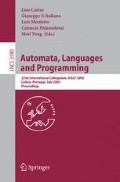Abstract
The “One-Time Pad” is a fundamental cryptographic protocol as it represents the ideal in secure unidirectional communication (i.e., in cases where there is a designated sender and a designated receiver) both in terms of security (in the presence of eavesdroppers) as well as in terms of computational efficiency. Surprisingly, no modeling and investigation of this protocol has been done in important practical settings, as distributed and asynchronous ones. In this work we introduce an asynchronous model for multidirectional and multi-player One-Time Pad asynchronous communication protocols. In this model the random pad is shared by all players, and there is no designated sender and receiver; in fact any participating player can act as a receiver at any given time, players communicate in a totally asynchronous fashion and may arbitrarily go off-line.
We define the problem of designing One-Time Pad asynchronous communication protocols, where the goal is that of maximizing the amount of the shared pad used before new randomness needs to be generated, with the constraint of mantaining the security property under reasonable adversarial assumptions on the relative behavior of the players and the network. We present lower bounds and protocol solutions for this problem that significantly improve over the obvious scenario where parties use an equal fraction of the pad. Our constructions are non-interactive in the sense that they require no additional synchronizing communication beyond the (usual) information that accompanies each ciphertext.
Copyright Telcordia.
Access this chapter
Tax calculation will be finalised at checkout
Purchases are for personal use only
Preview
Unable to display preview. Download preview PDF.
References
Anderson, R., Woll, H.: Algorithms for the Certified Write-All Problem. SIAM Journal on Computing 139(1), 1–16 (1997)
Aspnes, J.: Randomized protocols for asynchronous consensus. In: Invited survey paper for Distributed Computing, PODC 20th anniversary issue (2002)
Buss, J., Kanellakis, P., Ragde, P., Shvartsman, A.: Parallel Algorithms for Process Failures and Delays. Journal of Algorithms 20(196), 45–86 (1997)
De Prisco, R., Mayer, A., Yung, M.: Time-Optimal Message-Efficient Work-Performance in the Presence of Faults. In: Proc. of PODC 1994 (1994)
Dwork, C., Halpern, J., Waarts, O.: Performing Work Efficiently in the Presence of Faults. SIAM Journal on Computing 27, 1457–1491 (1998)
Fischer, M.J., Lynch, N.A., Paterson, M.: Impossibility of Distributed Consensus with One Faulty Process. JACM 32(2), 374–382 (1985)
Goldreich, O.: The Foundations of Cryptography, vol. 1. Cambridge University Press, Cambridge (2001)
Groote, J., Hesselink, W., Mauw, S., Vermeulen, R.: An Algorithm for the Asynchronous Write-All Problem based on Process Collision. Distributed Computing 14(2), 75–81 (2001)
Kanellakis, P., Shvartsman, A.: Efficient Parallel Algorithms Can Be Made Robust. Distributed Computing 5(4), 201–217 (1992)
Kowalski, D., Shvartsman, A.: Performing Work with Asynchronous Processors: Message-Delay-Sensitive Bounds. In: Proc. of PODC 2003, pp. 265–274 (2003)
Lamport, L.: Time, Clocks, and the Ordering of Events in a Distributed System. CACM 21(7), 558–565 (1978)
Luby, M.: Pseudorandomness and Cryptographic Applications. Princeton University Press, Princeton (1996)
Shannon, C.E.: A Mathematical Theory of Communication. The Bell System Technical Journal 27, 379–423, 623–656 (1948)
Vernam, G.: Secret Signaling Systems, US Patent (1919)
Author information
Authors and Affiliations
Editor information
Editors and Affiliations
Rights and permissions
Copyright information
© 2005 Springer-Verlag Berlin Heidelberg
About this paper
Cite this paper
Di Crescenzo, G., Kiayias, A. (2005). Asynchronous Perfectly Secure Communication over One-Time Pads. In: Caires, L., Italiano, G.F., Monteiro, L., Palamidessi, C., Yung, M. (eds) Automata, Languages and Programming. ICALP 2005. Lecture Notes in Computer Science, vol 3580. Springer, Berlin, Heidelberg. https://doi.org/10.1007/11523468_18
Download citation
DOI: https://doi.org/10.1007/11523468_18
Publisher Name: Springer, Berlin, Heidelberg
Print ISBN: 978-3-540-27580-0
Online ISBN: 978-3-540-31691-6
eBook Packages: Computer ScienceComputer Science (R0)

